I assume that not all LIBREAS readers at first knew what might be meant by the current issue’s main focus “library culture”. In this short report I’m going to summarize how I found – while currently studying in Sweden – my own definition of “library culture” and furthermore I will introduce a new library building in the (not so far) north as well: the recently opened Växjö universitetsbibliotek[Fn1].
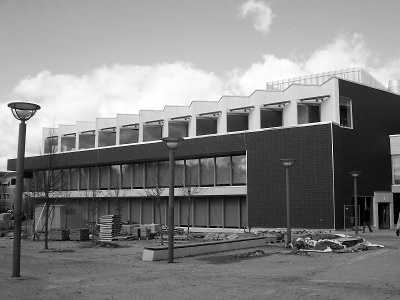
Växjö universitetsbibliotek
: general view
click to enlarge, ca. 145 kB
Since January I’m an exchange student at Växjö universitet while the official opening of the new library building took place on January 16th. As soon as I revealed myself as a “library person” during a guided library tour I found myself instantly in happiest accompany. At this time parts of the libraries’ ceiling were still not finished – so far two quite new experiences merged on the same day for a student used to “diffidence” and “order” in German university libraries.
In the following weeks I experienced myself in a quite different way of “acting in a library” and considering the libraries’ inner life I noticed different patterns of user and staff behaviour and therefore – by comparing my experiences in German university libraries and those I made or I am still making in the “final building phase” of Växjö universitetsbibliotek – I found out what “library culture” means to me.
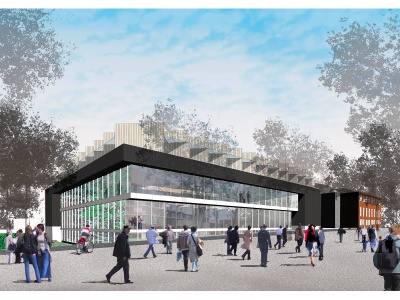
Växjö universitetsbibliotek
: sketch
click to enlarge, ca. 205 kB
From the beginning this university library made me feel of a folksy place where I’m looking forward to go with joy – either to work e.g. with classmates in one of the 32 various sized group rooms which can be booked online or to meet friends – aside from studying – on weekend days for a coffee in libraries’ Café “Astrakan”, where you can find most happy and friendly staff imaginable on a Sunday. This experience might not be a special new note for German students in general – but for me it is!
Besides Uppsala universitetsbibliotek[Fn2], Växjö universitetsbibliotek has the longest opening hours of university libraries in Sweden: On weekdays you can use the library from 8 in the morning till 10 in the evening (Monday – Thursday) or 6 in the evening (Friday). I’m especially sold on the opening hours on Saturday (10 AM – 6 PM) and Sunday (12 AM – 6 PM). The evening and weekend service is possible by employing Library and Information Science students[Fn3] which means a somehow limited service (e.g. regarding the reference and other information desk services) for users in the late hours of the day and on weekends. This seems to me to be a bearable “drawback” as from my experience most students using the library at these times rather come for simply reading and writing papers. They are escaping to the library from the diversest kinds of distractions they usually have to deal with in the student housings.
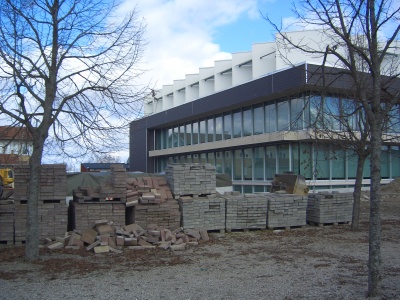
Växjö universitetsbibliotek
click to enlarge, ca. 230 kB
As a student used to quietness (or even silence) in the Prussian State Library reading rooms and not being allowed to bring any food or drinks (except of course as you may know the SLUB[Fn4] in Dresden because of some planning inadvertence of the air conditioning) you might feel queasy in Växjö’s hall at the beginning. Sometimes I even found myself on the verge of doing the “Psssst” (for German readers) or the “Shhhh!” (for international readers) people back home have to face if they are talking between the stacks and of course I did this turning around with a glare glance to the annoying group of guys dressed like going out on a Friday night on a Monday morning. Fortunately most of the exchange students (including me) hardly understand the Swedish language so you’re not disturbed by listening to exciting girl talks about all the topics girls usually prefer talk about instead of reading the 1000 pages tome on “Management Accounting”. However if you still feel disturbed you can use one of the two silent reading rooms on the 2nd floor.
Students are allowed to take in their bags, backpacks, coats, jackets and anything else one may carry around on a day spend on the campus. Of course the library offers lockers inside the library on the first floor but using it is an option not a command. Sometimes the students even bring coffee and sandwiches to their work places. The library staff first tried to get control of this behaviour, which looks even fearsome to the liberal Swedish librarians, but meanwhile, as the staff and the books are actually not extraordinarily threatened and there are enough possibilities to however keep one’s privacy and calmness, they stopped worrying and trust in the student’s sanity and honesty – and of course also Swedish libraries have a flawless working theft detection system.
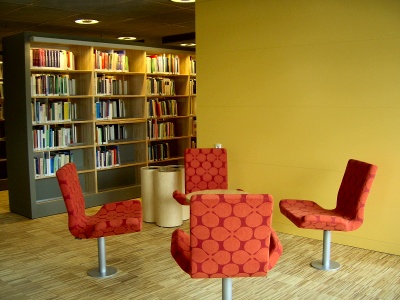
Växjö universitetsbibliotek
: interior
click to enlarge, ca. 181 kB
All (exchange) students I talked to about the library really like the building, its structure and its holdings with exception of the Swedish classification system[Fn5] which is unique also in Scandinavia and enjoys its usage since the early 20th century in both types of libraries – public and academic. As I heard there are discussions for a long time to change this unsatisfying state but all the talks did not come yet to some solution. However you can find students running around looking for titles they have on their course literature list – sometimes you even meet one of your classmates and then it’s a moral question: either tell him or her about your idea where the book might be shelved or hide, go on tiptoeing and try your guess to maybe find the right shelve and be the first to seize the very book you need…
Växjö University got a new library building already in summer 1995. At this time the reopening was a merging of two old library holdings, the old library building and the Special Library for Teacher Education. As I already mentioned there is a small building delay in completion of the current new building: The original plan was to open the ready-made building right after Christmas – the complete renewal is supposed to be finished in autumn 2006. According to the information given by the library staff there’ll be no other new building within the next 10 years. The current one is reasonable also factoring possible extension needs: In 1999 Växjö University became a full university (professorship, doctoral degrees) and had to integrate the holdings of the former separated School of Nursing and Social Work and the School of Police Education.
The holdings now comprise an amount of 225.000 books, additionally journals, magazines and newspapers in all the languages which are taught at the university. Taken all together the place is supposed to be spacey enough to hold 350.000 books. Working and computer places, study rooms, language and media laboratory and a multimedia room are spread of three library levels.
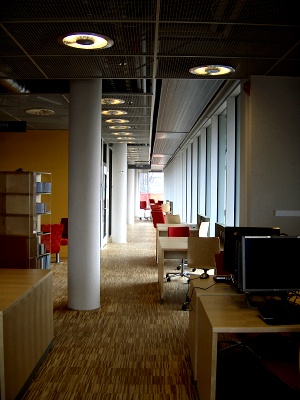
Växjö universitetsbibliotek
: inside
click to enlarge, ca. 157 kB
What more to say about my almost completely positive experiences?
A general trend for new buildings is implemented in this new building: Växjö universitetsbibliotek has no closed stacks. Instead it follows consistently the principle of open access to the holdings. The main holding part (e.g. parliament and government publications) is even placed in the libraries’ centre. More than 90 % of the holdings will be freely accessible when the building is finished in August 2006.
To be abroad and using a library in a foreign country enables you to understand library culture expressed – of course – by the DOs and DONTs, but as well by the way the collections are organized and the building is designed. And most of all you learn about a foreign library culture by experiencing and watching the ordinary people of a country using a library.
There might be a possible hypothesis, that as we shift in certain fields towards a global culture there might be a global library culture evolving too – something one may think of comparing new library buildings designed by most cosmopolite architects like Rem Koolhaas, Herzog & De Meuron or Snøhetta,. But on the other hand you still feel the very difference when you really step in the building and “live” the library. So to refine the hypothesis I’m sure that one will find both in future library culture: the big global element and the fine local specialities. Therefore world stays open for discovery. My advice to all those who are interested in learning more about library culture is a very simple one: Go discover! [Fn6]
Fußnoten
[Fn 1]
See www.vxu.se/bib/
(zurück)
[Fn
2]
See www.ub.uu.se
(zurück)
[Fn
3]
For information about the LIS program at Växjö University
„Biblioteks- och Informationsvetenskap” see: www.vxu.se/hum/utb/program/bop/eng/index2.html
(zurück)
[Fn
4]
For “Sächsische Landesbibliothek – Staats- und
Universitätsbibliothek Dresden“ (SLUB) see www.tu-dresden.de/slub/
(zurück)
[Fn
5]
See www.kb.se/Bus/SAB/sabheadings.htm
(zurück)
[Fn
6]
Due to the slogan of the last IFLA conference Libraries: A Voyage
of Discovery. (zurück)
Maxi Kindling studiert Bibliothekswissenschaft und Germanistische Linguistik (Magister) an der Humboldt-Universität zu Berlin.